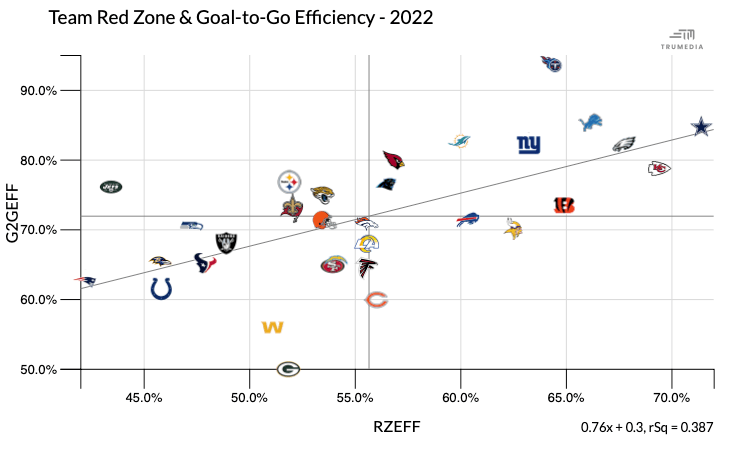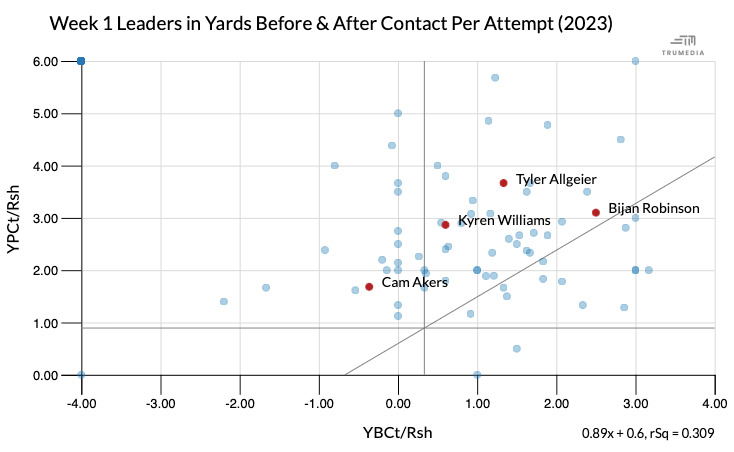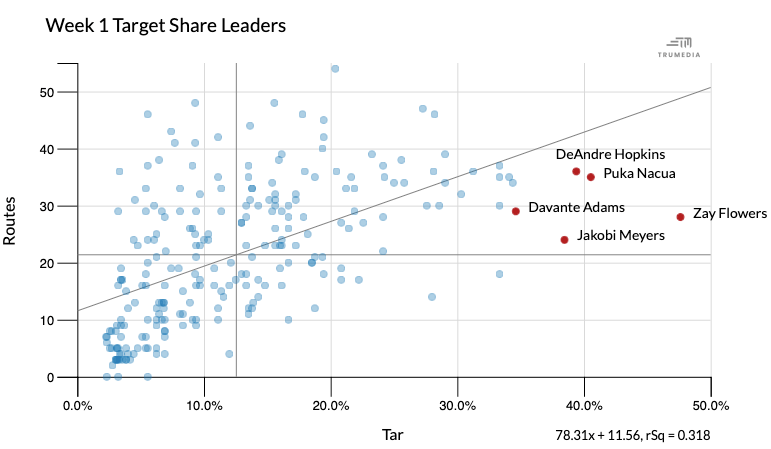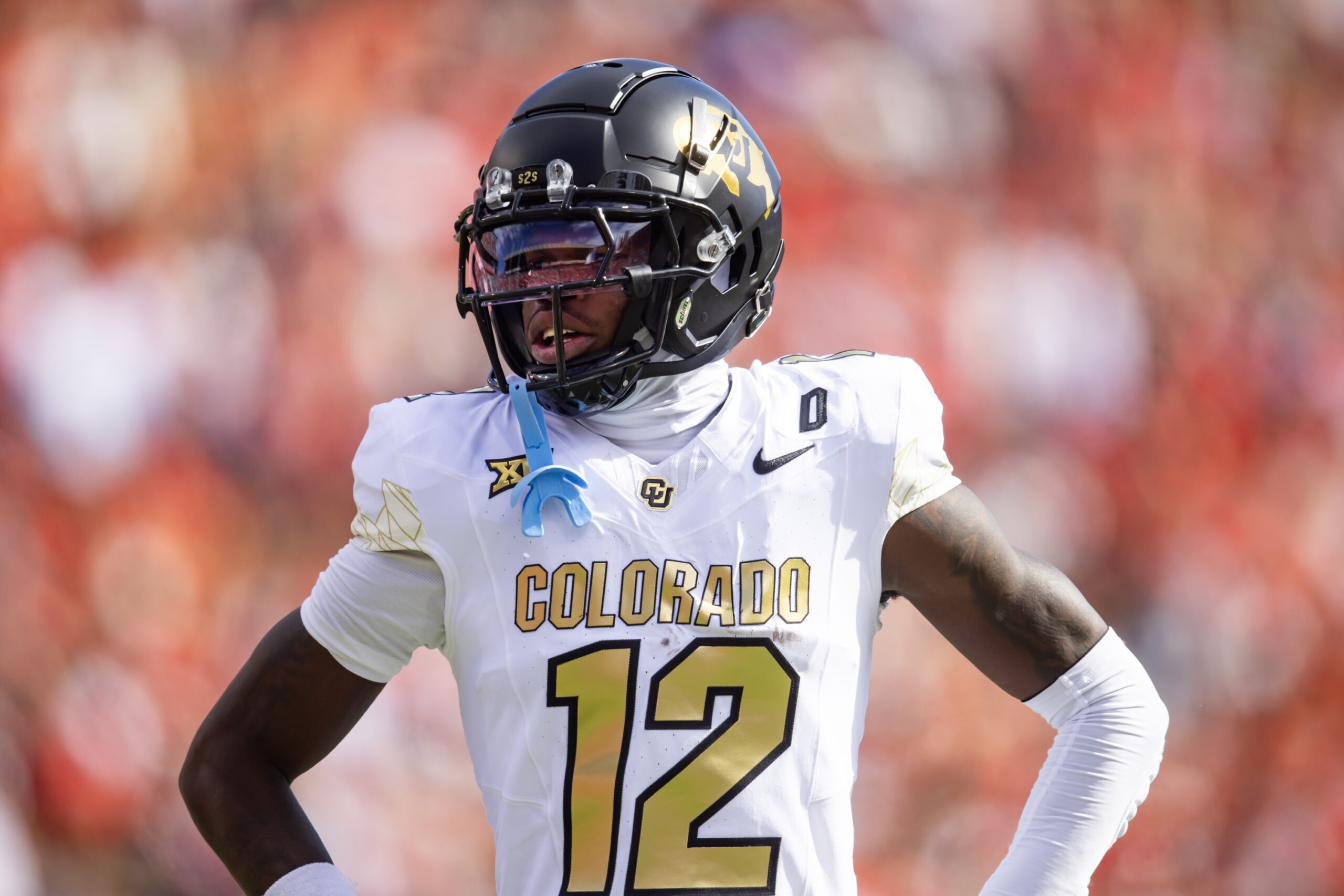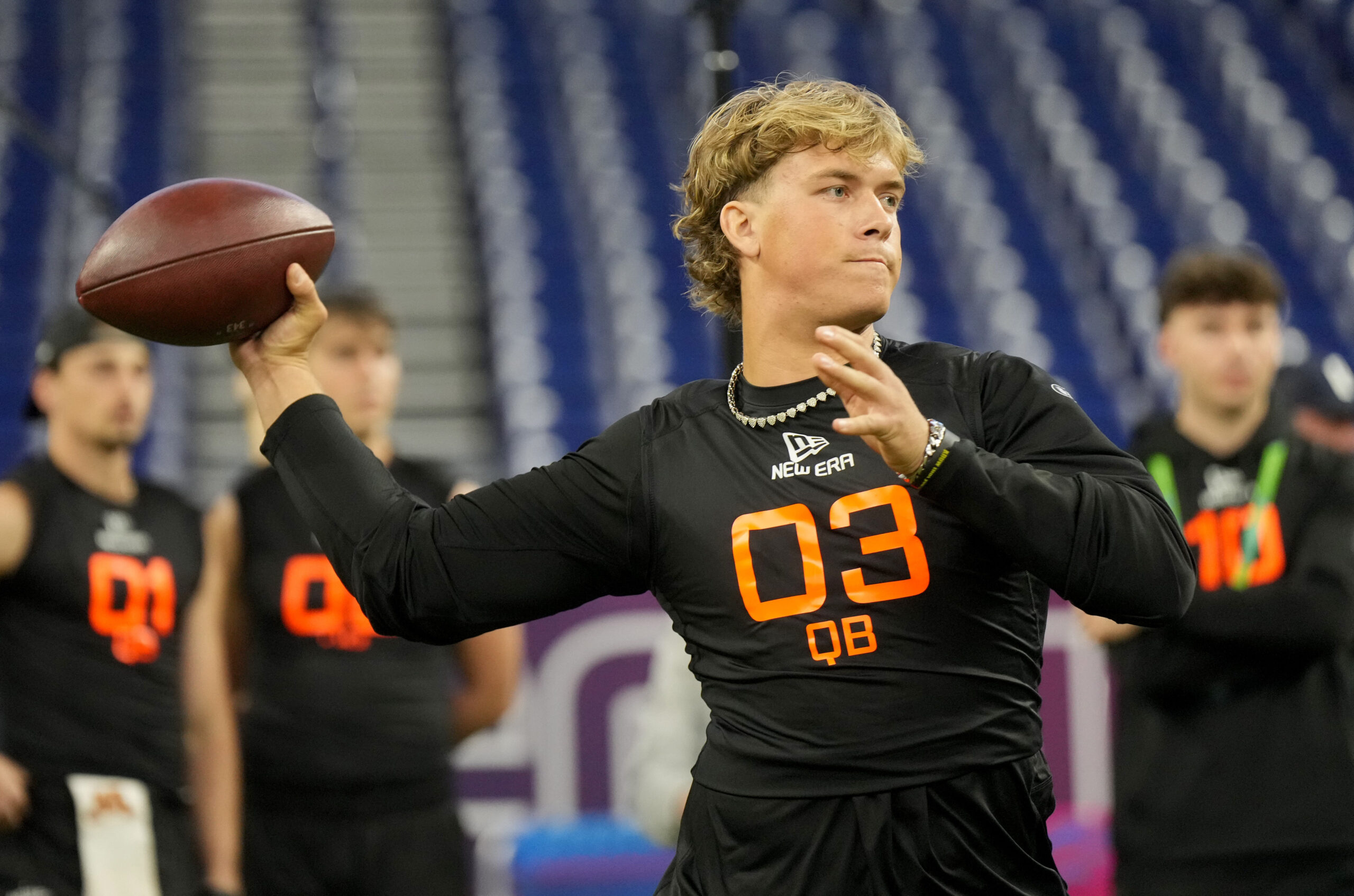Analysis
9/12/23
8 min read
2023 NFL Week 1 High-Value Touch Report: Rushing and Receiving Data
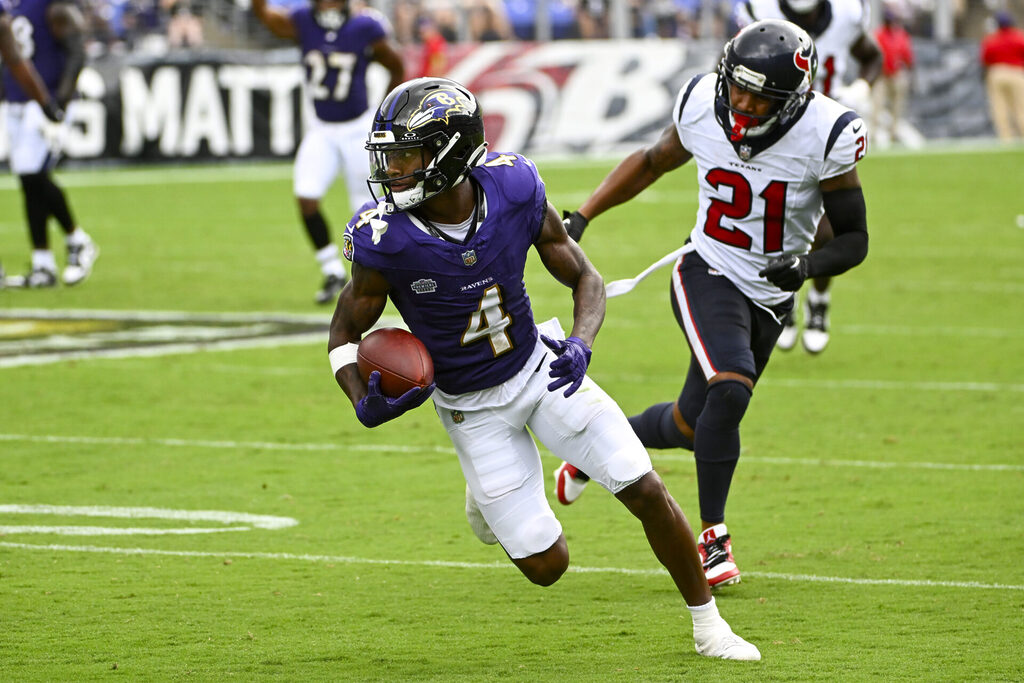
NFL Football is back, and so is the high-value touch report. In this article, we'll examine red zone and goal-to-go touches and opportunities. The context for these touches is important, so we'll consider the potential game script that led to the usage. This information helps identify which players might be on the verge of scoring more touchdowns and fantasy points and which players aren't.
Given the small sample, we sometimes find players don't regress quickly or that the data becomes more noisy than meaningful. Below, we'll review some of the 2022 high-value touch data with a look toward Week 1 metrics.
The information will be broken down by red zone and goal-to-go (GTG) rushing and receiving data to find usage patterns and expected fantasy points.
2022 Review
Let's quickly review the 2022 high-value touch data.
Jamaal Williams finished with the most red zone (57) and GTG (38) carries, plus the fourth-most efficient rushes per touchdown (3.56). Among qualified rushers, Williams landed behind Latavius Murray (2.00), Ezekiel Elliott (2.92) and Derrick Henry (3.27) in carries per touchdown in the red zone, as seen below.
Meanwhile, James Robinson (17.0), Aaron Jones (14.5), Tyler Allgeier (12.7), Kareem Hunt (12.5) and Brian Robinson (11.5) landed on the least-efficient list regarding carries per touchdown in the red zone. There's a good chance Allgeier and Robinson regress in touchdown rate in 2023.
DK Metcalf led all pass-catchers with a 40.3 percent target share in the red zone, with A.J. Brown (34 percent) and Drake London (33.3 percent) rounding out the top three. Metcalf and London seem the most surprising, suggesting optimism in 2023. Davante Adams garnered a 31.9 percent target share, with Stefon Diggs at 30.7 percent. Garrett Wilson finished sixth in red zone target share at 30.2 percent, the only other receiver with a percentage of 30-plus.
Last season, teams averaged more rushes in GTG situations (2.7) than targets (1.7). The league average rushes per touchdown sat at 3.14, with 16 players averaging three or better in rushing touchdown efficiency in these situations. Among quarterbacks, Jalen Hurts (2.1), Daniel Jones (2.8), Justin Fields (3.0) and Josh Allen (3.3) ranked in the top half of players in rushing touchdown efficiency in GTG situations.
Among running backs, Elliott (2.2) and Williams (2.5) finished as the most efficient touchdown scorers with a minimum of 20 or more carries in GTG opportunities.
Team-Level Data
The top five offenses in GTG efficiency (GTG touchdowns divided by GTG drives) include the Tennessee Titans (93.8 percent), Detroit Lions (85.4 percent), Dallas Cowboys (84.8 percent), Miami Dolphins (82.6 percent) and Philadelphia Eagles (82.4 percent).
Last season, the Lions totaled 17 passing touchdowns compared with 18 rushing touchdowns in GTG opportunities. Jamaal Williams soaked up 15 rushing scores, and Amon-Ra St. Brown had four receiving scores. Josh Reynolds, Shane Zylstra and Brock Wright tied with three GTG scores each. Hopefully, there's either some touchdown regression in St. Brown's favor or it doesn't end up so concentrated in one back.
Meanwhile, the least efficient offenses in GTG situations included the Green Bay Packers (50 percent), Washington Commanders (56 percent), Chicago Bears (60 percent), Indianapolis Colts (61.5 percent) and New England Patriots (62.5 percent). The visual above shows a scatter plot of teams with their red zone and GTG efficiency. We'll keep a close eye on the Commanders and Bears regressing, with the Packers being an intriguing offense with uncertainty in the passing game.
High-Value Touches: Red Zone Rushing
It's a one-game sample, but David Montgomery followed Williams' trajectory from last season with a 62.1 percent rush share on first and second down against the Chiefs. Rookie RB Jahmyr Gibbs garnered a 24.1 percent rush share on first and second downs but bested Montgomery in yards after contact (4.4 vs. 2.5).
Montgomery also hogged 66.7 percent of the carries (four) in the red zone compared with Gibbs at 16.7 percent (one). However, neither Lions back had a carry in GTG situations.
Before Monday night, Josh Jacobs, Austin Ekeler, Joshua Kelley and Kyren Williams tied with five red zone carries. Kelley's usage might be the most surprising, with Williams also taking away touchdown opportunities from Cam Akers. In Week 1, Ekeler and Kelley tied with a 40 percent team rush share.
Meanwhile, Akers edged Williams with 55 percent vs. 37.5 percent of their team's rush share. However, Williams bested Akers in rush share (47.8 percent vs. 43.5 percent) in the first three quarters, as seen in the table above. Then the Rams leaned on Akers to close out the game, with 54.5 percent of his carries coming in the fourth quarter. Kelley and Williams deserve a roster spot, given their redzone involvement.
Tony Pollard finished Week 1 with a week-leading total of seven red zone carries and two rushing scores. Three of the seven red zone carries came in GTG situations. Though Breece Hall stole the show with his massive breakaway runs, Dalvin Cook garnered five of the six running back carries in the red zone, while QB Zach Wilson took two.
Cook struggled with efficiency with only three yards on five red zone rushes. The opportunities for Hall (12) and Cook (15) might be relatively even for the first few weeks, but both rushers have value and upside.
High-Value Opportunities: Red Zone Receiving
On Thursday, Lions receivers St. Brown and Marvin Jones had one target each in the red zone, and St. Brown scored a nine-yard touchdown. Tyreek Hill tied with Zay Flowers for the league lead in redzone targets. Here's a wild stat: Hill produced 92.6 percent of his Week 1 receiving yardage outside of the red zone. When Tua Tagovailoa targets Hill for explosive downfield plays and closer toward the end zone, it's the complete package.
Jake Ferguson looks like a solid red zone option for Dak Prescott and led the team in targets in Week 1. However, the Cowboys demolished the Giants, so this game might not be an accurate reflection of their passing game going forward. Regardless, Ferguson is a sneaky TE2 option that doesn’t have the hype or name value. Last season, Dalton Schultz led the team in red zone opportunities (16).
High-Value Touches: Goal-to-Go Rushing
Unfortunately, J.K. Dobbins suffered yet another season-ending injury, an Achilles tear. Dobbins scored on his only GTG opportunity, but fellow Raven Justice Hill scored twice on his four GTG carries. Gus Edwards will be a factor, but he had zero GTG opportunities in Week 1.
Williams scored two touchdowns on four GTG carries, with Akers scoring on one of two. We'll want to monitor the usage going forward because it concerned fantasy managers when Williams scored and produced early in the game.
Besides the two touchdowns in quarters in the first three quarters, Williams just about matched Akers in carries (11 vs. 10) with more rushing yards (36 vs. 13). Interestingly, Williams also created more yards after contact than Akers (3.1 vs. 1.7) during the first three quarters, as seen in the visual below. Again, there's potential small-sample noise, but this is the data we have from Week 1.
Allgeier landed in my ZeroRB targets and stashes, and he ranked as RB4 in PPR leagues before Sunday night. He scored two touchdowns on four of his GTG carries, while Bijan Robinson saw zero. In Week 1, Robinson and Allgeier flashed their ability to fight for extra yards.
Robinson boasted 3.1 yards after contact per attempt, with Allgeier at 3.7. The Panthers were tied with the Falcons heading into the fourth quarter, and Atlanta rested Robinson in the final period. Allgeier garnered nine of his 15 carries in the fourth quarter (60 percent), compared with Robinson's one of 10 (10 percent).
High-Value Opportunities: Goal-to-Go Receiving
Las Vegas WR Jakobi Meyers hardly received any publicity but reeled in two of his three GTG targets for touchdowns. Adams garnered one GTG opportunity, but the Raiders' passing offense remained consolidated in target share between Meyers (38.5 percent) and Adams (34.6 percent).
The visual below shows the overall leaders in target share in Week 1.
Maybe most of the Broncos' defensive coverage leaned toward Adams, or Meyers might be that short- to medium-area target Jimmy Garoppolo prefers, with 6.9 air yards per target (AY/T). If Meyers maintains a high-end target share in a consolidated passing offense, he’ll be an undervalued steal in leagues.
Three of Flowers' 10 targets came in GTG situations but mostly came behind the line of scrimmage, with -3.33 AY/T. Though the Ravens didn't need to rely on the passing game, it's positive to see Lamar Jackson connect with the rookie. Keep stashing Flowers while we assess his usage in the coming weeks.
In Green Bay, without Christian Watson, Romeo Doubs garnered two targets in GTG opportunities and scored both times. Jordan Love spread the ball around, with Jayden Reed and Doubs tied with five targets (18.5 percent) in a game where they had a positive game script.
Follow The 33rd Team Podcast Network on Spotify and Apple Podcasts.



